Notice
Transition is currently unavailable. Maintenance in progress.


Non-Contact Propulsion via Permanent Magnet Arrays.
Advances in materials science have enabled the production of industrial magnets
with extremely high magnetic energy density. Of particular importance are
compounds based on neodymium, iron, and boron, among which the tetragonal
Nd₂Fe₁₄B phase is the most studied and widely applied. These materials are
produced via powder metallurgy: rare-earth and transition metal elements
undergo sintering followed by magnetic alignment in a high-intensity field.
One of the most energetically saturated commercial grades is the NdFeB N52M
type. Its remanent magnetic induction reaches 1.48 T, coercive force is at least
836 kA/m, and maximum magnetic energy product exceeds 390 kJ/m³. The "M"
designation indicates an allowable operating temperature up to 100°C, at which
the stated parameters are retained. These characteristics make magnets of this
class benchmark components in applied and research tasks requiring compact yet
powerful and stable magnetic field sources.
The development and serial production of high-energy NdFeB magnets, particularly
the N52M type, have enabled precise engineering control of magnetic interactions.
This has driven the creation of new designs and models across several
technological fields. Notably, the use of such magnets underpins applied
magnetic research conducted by entities including the NIMEC research division.
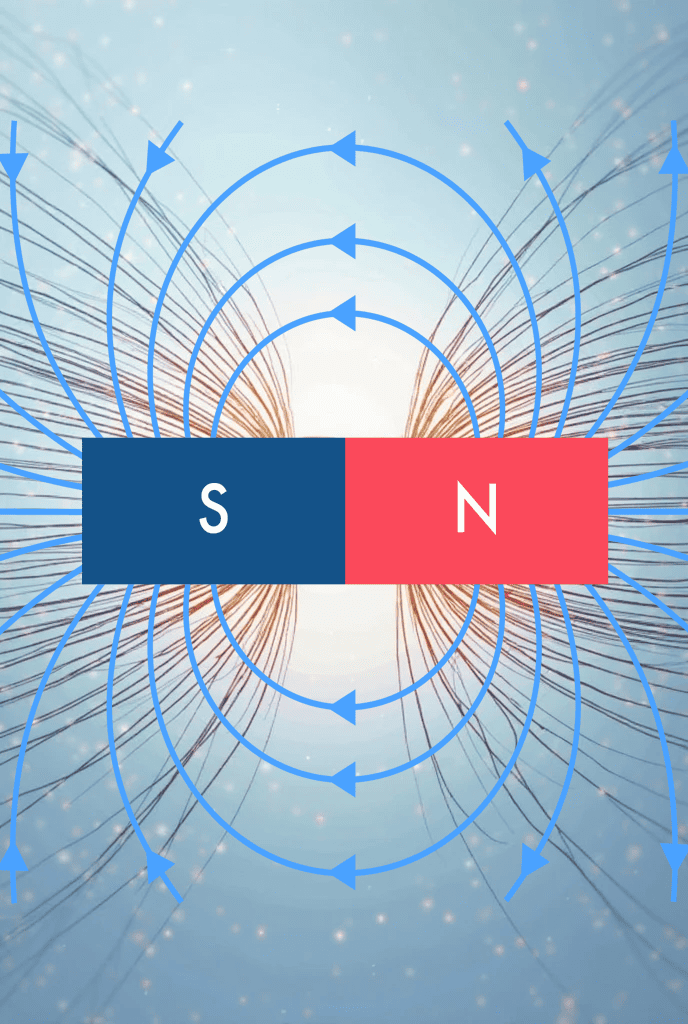
The production of modern permanent magnets is based on a technological process
involving powder preparation, sintering, and magnetic alignment within a strong
external magnetic field. During these operations, a significant amount of energy
is introduced and fixed within the magnet, which then manifests as a magnetic
field.
The energy required to create a permanent magnet is spent on altering the
internal structure of the material, organising magnetic domains, and overcoming
energy barriers, resulting in a stable magnetised state. Thus, a permanent
magnet represents an energy-saturated system, analogous to a battery or
accumulator, capable of retaining the stored energy for extended periods.
This fact justifies considering permanent magnets as energy devices with
accumulated energy, enabling precise quantitative accounting and modelling of
magnetic interaction processes, similarly to calculations used for
electrochemical accumulators.
The physical nature of magnetic fields lends itself to quantitative description
through a set of well-defined parameters. Among the most fundamental are
magnetic flux density (B), magnetic field strength (H), magnetic flux, and the
magnetic permeability of the medium.
Magnetic flux density (B) is a vector quantity that characterises the strength
of a magnetic field in terms of the force it exerts on moving electric charges
and magnetic materials. It is measured in tesla (T). Instruments such as
gaussmeters and vector magnetometers are used for its measurement.
Magnetic field strength (H) describes the intensity of a magnetic field
generated by electric currents and magnetic dipoles within a material. It is
measured in amperes per metre (A/m) and typically determined using Helmholtz
coils and current probes calibrated for spatial field distribution analysis.
Magnetic flux is defined as the product of magnetic flux density and the area it
penetrates, and is measured in webers (Wb). Magnetic permeability, in turn,
reflects a medium’s ability to conduct magnetic flux and is expressed in henries
per metre (H/m).
The development of accurate measurement techniques for these quantities has
made it possible to formalise magnetic interactions and establish a mathematical
basis for their modelling. Calculations based on the finite element method (FEM)
accommodate complex geometries, nonlinear material properties, and spatial
current distributions. Among the most advanced software platforms used in this
domain are COMSOL Multiphysics and ANSYS Maxwell, which enable detailed dynamic
modelling of magnetic systems.
Access to precise parameters, specialised instruments, and reliable
computational tools has transformed magnetic field analysis from a descriptive
discipline into a predictive engineering practice. Permanent magnets are no
longer abstract sources of force; they have become controllable components
within engineered systems. As a result, in contemporary machines and mechanisms,
permanent magnets are employed as active functional elements — on par with
energy sources, control modules, and actuators.
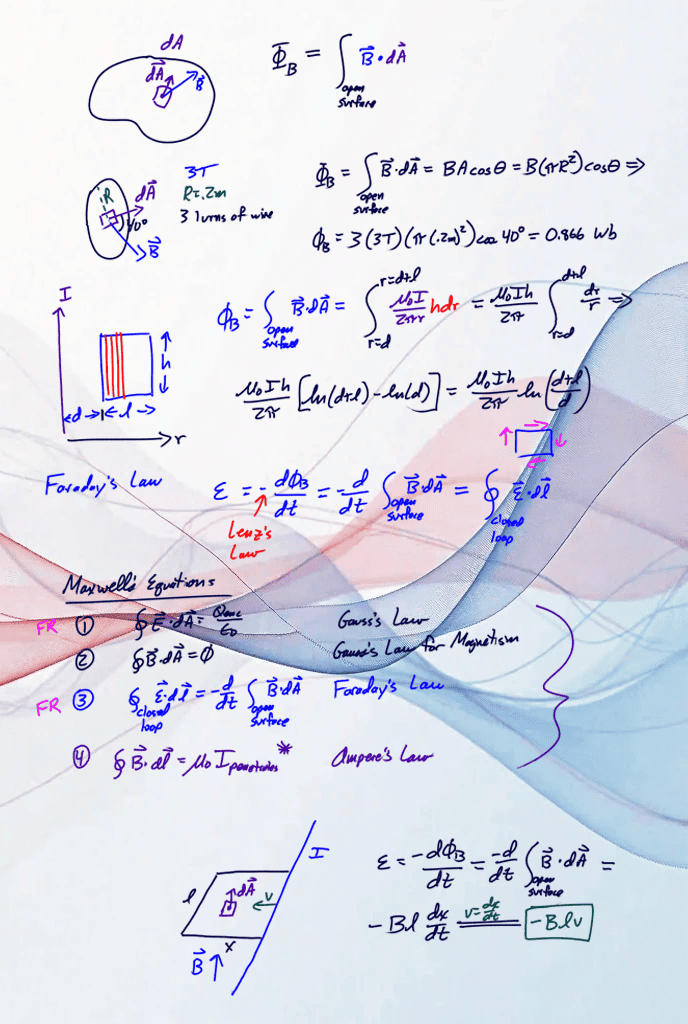
The formalisation of the physical parameters of magnetic fields, the advancement
of measurement techniques, and the introduction of reliable modelling tools have
enabled a transition from descriptive observation of magnetic interactions to
their purposeful engineering application. Modern permanent magnets are now
regarded as functional components of technical systems, characterised by
predictable properties and high energy density.
The most significant area of application is in electric power generation. In
such generators, the magnetic flux is established without the need for external
excitation current, leading to a simplified construction, reduced thermal
losses, and improved energy efficiency. The use of neodymium-iron-boron (NdFeB)
based materials—particularly those of the N52M grade—enables high flux densities
to be achieved within compact dimensions while maintaining operational stability
under thermal and mechanical stress.
In brushless electric motors (BLDC, PMSM), permanent magnets act as stable
sources of magnetic flux in the rotor. This configuration eliminates the need
for moving electrical contacts, thereby improving reliability and controllability.
These motors are widely used in drones, electric vehicles, servo drives, and
compact traction systems, including hub motors. The high coercive stability of
modern magnets ensures consistent performance even under varying external
conditions.
In both household and industrial applications, permanent magnets are utilised in
the drives of pumps, fans, and compressors, as well as in acoustic systems and
sensors. The long-term stability of their magnetic properties ensures reliable
operation with minimal maintenance requirements over extended service periods.
In medical technology, magnets are applied in devices for magnetic therapy, in
systems for magnetic navigation of microrobots, and in magnetic resonance
imaging (MRI). In the latter, field stability in both space and time is
critical—a requirement that can only be met by high-energy permanent magnets
with tightly controlled material properties.
In measurement technology, magnets form integral parts of Hall effect sensors,
magnetoresistive elements, and magnetic positioning systems. Their compactness
and lack of power consumption make them particularly suitable for use in
telecommunications equipment, security systems, and precision instrumentation.
Thus, permanent magnets are not merely auxiliary components but key structural
elements of modern technical systems. Their properties are not only accounted
for in design processes, but actively define both the limitations and
capabilities of the system as a whole. This elevates the magnet to the status
of an active engineering tool—on par with power sources, control electronics,
and mechanical assemblies.
Magnetic interactions are based on a fundamental principle of polarity, which
determines the direction of forces of attraction and repulsion between magnets.
Each magnet has two poles — north (N) and south (S) — and the interaction
between them follows the rule: like poles repel, unlike poles attract.
Although simple, this rule underlies complex magnetic systems and defines the
nature of mutual forces in magnetic arrays. The magnitude and direction of the
force depend on the orientation of the poles relative to each other and the
distance between them. The force is inversely proportional to the square of the
distance, reflecting Coulomb’s law as applied to magnetic forces.
Understanding and applying the principle of magnetic polarity is key to
designing systems that require precise control of magnetic forces, such as
motors, generators, and magnetic couplings. Without consideration of polarity,
stable and efficient operation of magnetic devices is impossible.

The interaction of magnetic fields is fundamentally influenced by the spatial
configuration of the magnets — their shape, orientation, and relative
positioning. These parameters determine not only the magnitude but also the
nature of the magnetic interaction, affecting the distribution of the magnetic
field in space.
The shape of the magnets — whether cylindrical, prismatic, ring-shaped, or
complex composite structures — defines local field characteristics and creates
zones of varying magnetic intensity. The distance between magnets influences
the force of attraction or repulsion, with the force diminishing rapidly as
distance increases, in accordance with the inverse-square law.
Furthermore, the orientation of the poles relative to one another and the
angles between magnets can significantly alter the nature of the interaction,
producing complex effects employed in engineering applications for precise
control of motion, fixation, and force transmission without physical contact.
Therefore, understanding and accounting for the spatial configuration of
magnetic systems enables the design of efficient and controllable magnetic
devices, thereby expanding the scope of permanent magnet applications in modern
technologies.
The magnitude of the field is proportional to both the current and the number
of coil turns. However, increasing the current leads to greater thermal stress
in the coil, resulting in additional energy losses. Therefore, the energy
efficiency of an electromagnet is limited by the ratio between the required
field strength and the acceptable level of power consumption.
To achieve a high field intensity, either the current must be increased or the
magnetic circuit must include materials with high permeability. Both approaches
influence the design volume and thermal management of the device.
The key parameters defining electromagnet characteristics include the number of
coil turns (N), the current (I), the magnetic path length (l), the core
cross-sectional area (S), and the magnetic reluctance (Rₘ), which depends on
the material and geometry of the system.
Electromagnets are employed where a controllable field is required: they can be
switched on, off, or adjusted without mechanical modification. This
controllability makes them essential components in systems for actuation,
control, power conversion, and magnetic separation.
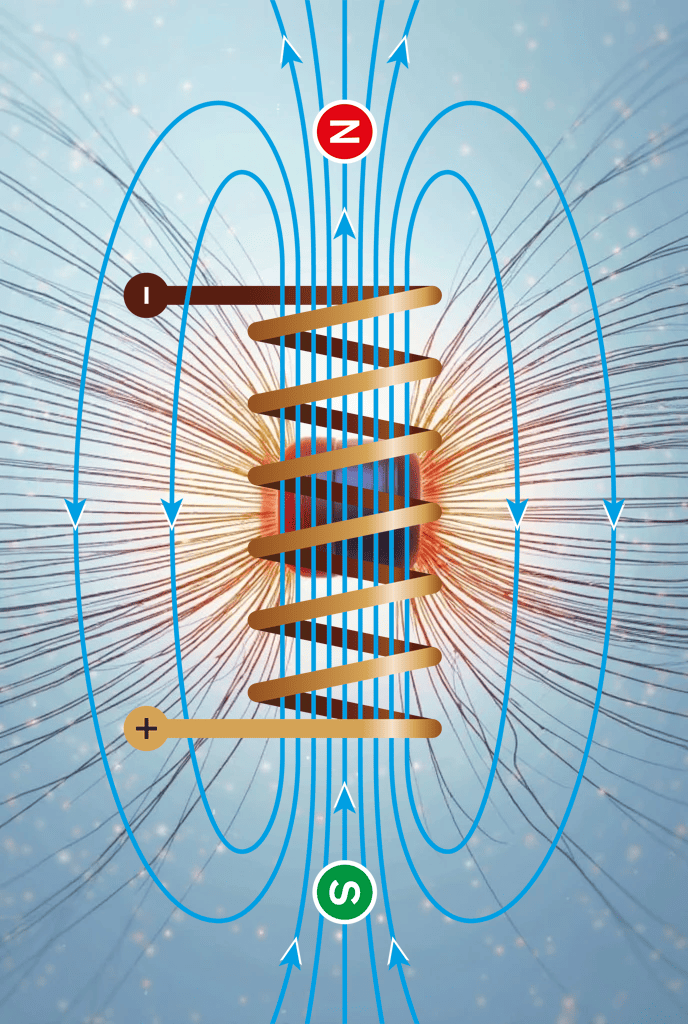
The combination of permanent magnets and electromagnetic windings is widely
employed in modern electrical machines, particularly in permanent magnet
synchronous motors (PMSMs). This configuration leverages the benefits of both
magnetic sources: the stability and high flux density provided by permanent
magnets, and the controllability and dynamic performance enabled by
electromagnetically generated fields.
The permanent magnet establishes the primary magnetic field in the air gap of
the machine, supplying rotor magnetisation without the need for external
excitation. This significantly reduces energy consumption, as no excitation
current is required and a portion of the mechanical load is offset from the
active windings.
The stator’s electromagnetic windings generate a rotating field that interacts
synchronously with the rotor’s field. This interaction results in high
efficiency and precise torque control. The higher the magnetic induction
produced by the permanent magnet, the lower the current needed to generate the
desired torque, directly reducing thermal losses and improving overall system
efficiency.
With the use of high-coercivity materials such as NdFeB of class N52M, high
magnetic flux density can be achieved within a compact volume. This facilitates
simplified motor integration and extends the operational range of the system.
Such combined magnetic configurations are particularly effective in traction
drives, drones, automation systems, and electric vehicles, where compactness,
reliability, and low energy losses are of critical importance.
The original concept proposed by Nikola Tesla in the late 19th century involved
a commutated system of four energy storage elements connected in such a way
that the current induced in a coil by the motion of a permanent magnet would
not be dissipated but redirected to charge other components within the circuit.
In such configurations, the coil simultaneously functions as both an
electromagnet and a generator. When excited by a moving permanent magnet, it
produces an induced current which, in most conventional designs, is either
grounded or actively suppressed.
Tesla’s innovation lay in his proposal to utilise this induced current to
alternately charge capacitors, thereby partially offsetting the energy required
to sustain the magnetic field. In its classical implementation, switching was
performed mechanically and constrained by the technological limitations of the
time.
With the advent of modern graphene-based supercapacitors, this concept has
gained renewed practical relevance. These energy storage devices exhibit high
current density, low internal resistance, and an exceptional ability to absorb
charge rapidly. Unlike traditional capacitors, graphene supercapacitors are
well-suited to capturing short bursts of current generated as a permanent
magnet moves relative to a coil.
Owing to these properties, a modern reinterpretation of Tesla’s switch no
longer depends on high switching frequencies. Rapid charging combined with
controlled, gradual discharge enables energy-efficient use of the electrodynamic
interactions intrinsic to the system. As a result, a portion of the energy
previously lost as heat or through grounding can now be recovered and reused
within the circuit, or diverted to auxiliary subsystems.
This contemporary implementation of Tesla’s concept, enabled by advances in
materials science, remains fully consistent with established physical
principles while offering engineers a means of improving energy balance in
systems involving dynamic magnetic fields. It elevates a historical invention
to a viable and efficient design strategy for next-generation autonomous drive
systems.
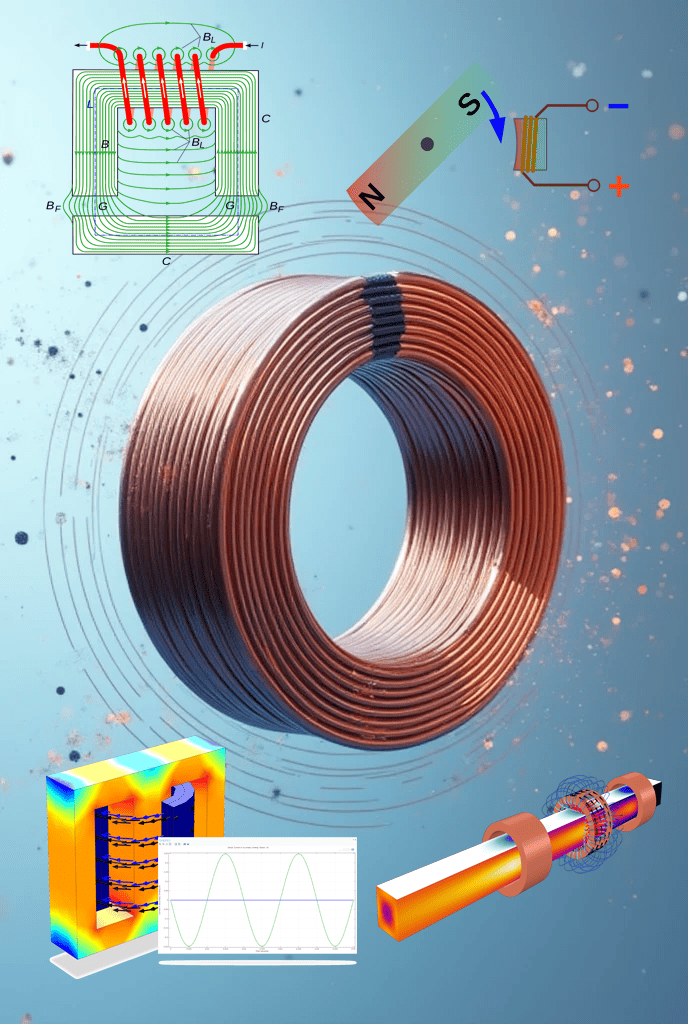
Modern demands for compactness, energy efficiency, and thermal stability in
electromagnetic devices have driven the adoption of advanced materials in both
core and structural components of coils. The choice and combination of these
materials play a critical role in determining the performance and reliability
of devices in industrial environments.
For magnetic cores, alloys with high magnetic permeability and saturation
induction are increasingly utilised. One such material is Permendur—an
iron-cobalt-vanadium alloy (Fe-Co-V)—which offers saturation induction values
up to 2.4 T and low core losses under high-frequency conditions. Due to its
high coercive stability and thermal resilience, Permendur is particularly
effective in devices subjected to variable thermal and mechanical loads. Its
use enables a reduction in core volume while maintaining the required magnetic
induction, thereby decreasing the overall weight and size of the assembly.
In parallel with advances in core materials, structural design solutions are
evolving. The widespread application of 3D printing with polymeric and
composite materials—tailored for specific dielectric and mechanical
properties—facilitates the fabrication of coil housings and supports with high
dimensional precision. This enables optimisation of magnetic system geometry,
reduction of inter-winding gaps, and an increase in winding density. Adapting
the enclosure geometry to the magnetic field configuration reduces parasitic
losses and promotes more uniform heat distribution.
Special attention is given to conductive materials. Advances in electrolytic
copper production have lowered the cost of high-purity conductors. The use of
99.99% pure copper reduces ohmic losses and allows for higher current capacity
without increasing conductor cross-section. This is especially critical for
windings operating under pulsed conditions or in thermally constrained
environments.
The integration of these innovations allows the construction of electromagnets
with higher magnetic energy density, reduced mass and volume, and improved
thermal stability. The application of novel materials and manufacturing
techniques not only enhances device efficiency but also supports adaptation
to emerging functional requirements in energy systems, transportation, and
automation.
Electric motors are devices in which magnetic field energy is converted into
mechanical work through the interaction between electric current and magnetic
flux. Regardless of the specific construction, all motors operate on the same
fundamental physical principles: the force acting on a current-carrying
conductor in a magnetic field (Ampère’s law) and the phenomenon of
electromagnetic induction (Faraday’s law).
The core of any motor is its electromagnetic system, which generates the working
magnetic field. The interaction between this field and the current in the
windings produces a torque, the magnitude of which depends on the current
strength, field configuration, and geometric arrangement. Most motor designs
incorporate ferromagnetic cores to concentrate and guide the magnetic flux,
thereby reducing energy losses.
The performance of an electric motor is determined by the parameters of its
magnetic circuit: magnetic induction, field intensity, air gap dimensions, and
the properties of the materials used. Magnetic interaction thus forms the
fundamental physical basis for rotational motion, and the control of this
interaction is central to engineering optimisation.

Permanent magnet electric motors (BLDC, PMSM) exhibit high energy efficiency,
resulting in lower power consumption while delivering comparable mechanical
performance relative to conventional brushed motors.
For example, the brushless ATO-180WDM16030 motor, rated at 5 kW with a supply
voltage of 48 V and a current of 123 A, provides a nominal torque of 16 Nm and
a peak torque of up to 42 Nm. In contrast, the traditional Lynch LEM-170 brushed
motor, operating at the same voltage of 48 V but with a higher current of 140 A,
produces a nominal torque of approximately 14.4 Nm and a peak torque around 16.2
Nm.
Despite the higher current in the brushed motor, its peak torque is
significantly lower than that of the ATO brushless motor. Furthermore, the
BLDC motor achieves an efficiency of up to 98%, compared to 89% for the brushed
counterpart. The higher efficiency and lower current demand of the BLDC motor
translate into reduced energy consumption and decreased thermal losses.
The absence of brushes reduces mechanical losses and wear, while the use of
permanent magnets in the rotor eliminates the energy expenditure required to
generate the magnetic field, further enhancing overall efficiency.
Therefore, permanent magnet motors enable maximisation of torque output with
optimised energy consumption, which is particularly crucial in
energy-constrained applications such as drones, electric vehicles, and mobile
robotics.
Permanent magnets have found widespread use in electric motors and generators,
becoming an integral part of modern technological solutions. These devices have
undergone extensive development and testing, proving their reliability,
efficiency, and durability across a wide range of fields — from industrial
manufacturing to consumer electronics. Particularly important are magnets based
on neodymium-iron-boron (NdFeB) alloys, which today are the standard in most
high-performance electromagnetic systems due to their high magnetic energy and
stability.
The use of permanent magnets in motors and generators reduces energy
consumption, decreases the mass and size of equipment, and simplifies design by
eliminating the need to power rotor windings. All this contributes to the
creation of compact, powerful, and economical solutions that are in demand in
modern industry.
These technologies have stood the test of time and operational use, as evidenced
by their widespread application in aviation, automotive engineering, robotics,
and energy sectors. The reliability and efficiency of permanent magnets in
electrical engineering are the result of many years of research and engineering
achievements, integrated into standardised manufacturing processes.
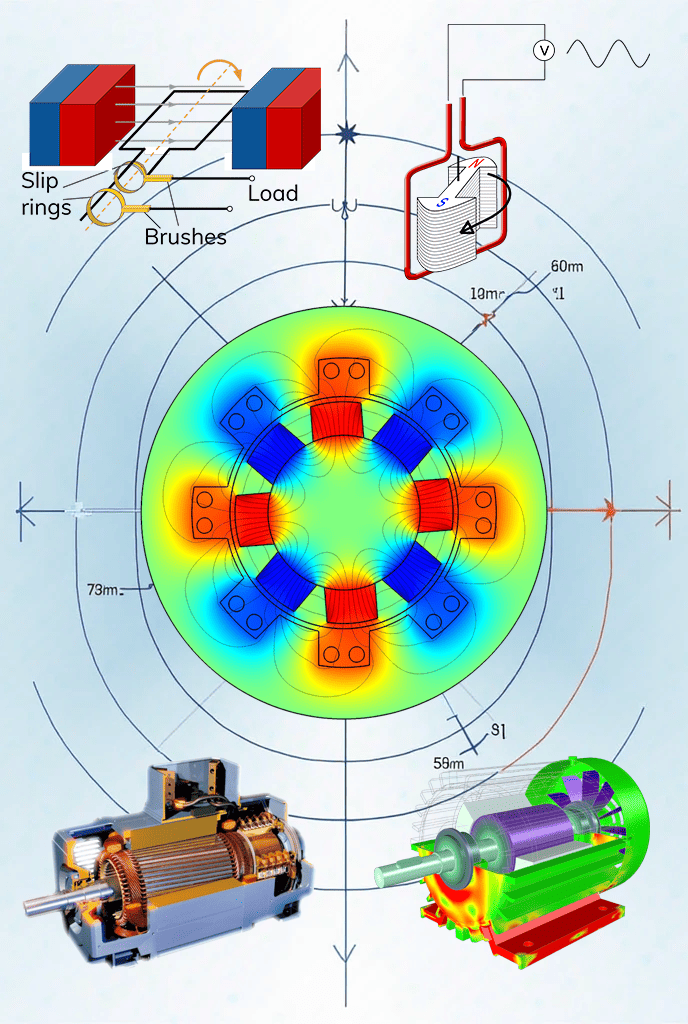
Mathematical modelling of magnetic fields has become an essential tool in the
development and optimisation of electromagnetic devices. Modern software
packages enable highly accurate predictions of magnetic field distribution,
calculation of force characteristics, and assessment of system behaviour under
various operating conditions.
Modelling technologies significantly reduce the time and cost of prototyping,
allowing the exploration of design and material options at the early stages of
development. These tools help engineers identify bottlenecks, optimise the
geometry of coils and cores, and predict the efficiency and heating of
equipment.
Widely used methods include finite element analysis, boundary element methods,
and integral equations, providing precise numerical solutions for complex
magnetic systems. Validation of modelling results against experimental data
confirms the reliability and applicability of contemporary computational
techniques.
Thus, the capability for mathematical modelling of magnetic fields paves the
way for the creation of highly efficient and innovative electromagnetic devices,
ensuring their stable and predictable operation.
NIMEC does not utilise untested materials or experimental components. Its
innovations are not based on altering the physical foundations of
electromechanics, but rather on the advanced engineering integration of
well-established and thoroughly validated principles. NIMEC reinterprets
the interaction between electromagnets and permanent magnets by drawing upon
the collective scientific knowledge accumulated over decades, applying it in
novel configurations of connection and control.
Unlike conventional permanent magnet motors, in which electromagnets operate
continuously and therefore consume energy at all times, NIMEC employs a pulsed
operational mode. Electromagnets are activated only when a change in the
system’s state is required; at all other times, energy consumption is
effectively zero. This strategy results in a substantial reduction in power
usage without compromising mechanical performance.
During the inactive phase of the electromagnet, rotation is sustained through
the attractive force between the permanent magnet and the ferromagnetic core,
which serves as an energy reservoir via the magnetic field. The motor’s
structural design enables mechanical advantage by increasing the rotor diameter.
Magnetic attraction acting at a greater radius produces higher torque, thereby
exploiting the principle of leverage to enhance output force without raising
energy consumption.
During the inactive phase of the electromagnet, rotation is sustained through
the attractive force between the permanent magnet and the ferromagnetic core,
which serves as an energy reservoir via the magnetic field. The motor’s
structural design enables mechanical advantage by increasing the rotor diameter.
Magnetic attraction acting at a greater radius produces higher torque, thereby
exploiting the principle of leverage to enhance output force without raising
energy consumption.
The company further implements concepts originally proposed by Nikola
Tesla—particularly the idea of a switching mechanism whereby the coil of the
electromagnet, during its interaction with the permanent magnet, functions not
only as an actuator but also as a generator. In standard designs, the induced
current from this interaction is typically grounded and wasted. In contrast,
NIMEC captures this current and directs it to recharge energy storage units.
This approach allows for the recovery and reuse of transient energy impulses,
maximising overall efficiency.
For energy storage, NIMEC utilises advanced graphene-based supercapacitors
capable of accepting charge within fractions of a second while maintaining a
prolonged, stable discharge. Their use significantly extends the system’s
autonomous operational period without requiring external recharging.
In summary, NIMEC does not promise speculative or theoretical solutions.
Rather, it delivers a rigorously engineered system that combines time-tested
physical principles with cutting-edge technology. The result is a highly
energy-efficient, long-lasting, and mechanically reliable platform—one
grounded not in conjecture, but in physics and demonstrable engineering logic.
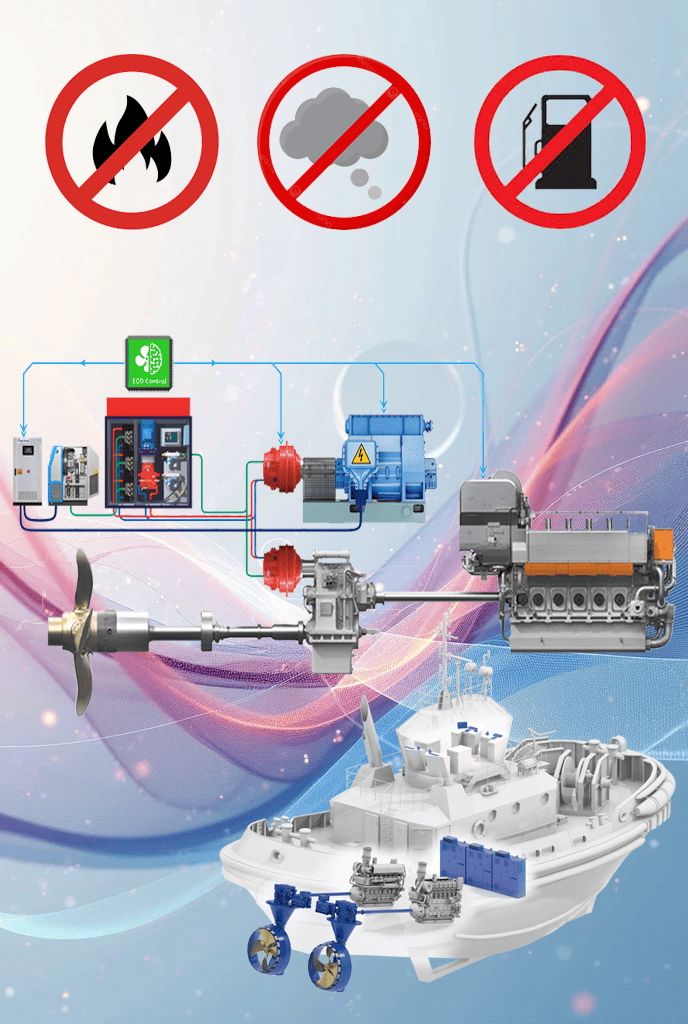
NIMEC has developed an efficient concept that integrates its ultra-low-energy
electromagnetic drive with hydraulic systems. By employing a pulsed
electromagnetic motor supported by permanent magnets acting as energy
accumulators, the system significantly reduces electrical power consumption
without compromising performance.
This motor drives a hydraulic pump, generating fluid flow at the required
pressure and volume. The resulting hydraulic energy is then distributed to
actuating components—hydraulic motors capable of producing both linear and
rotational motion. These hydraulic motors can be applied to drive marine
propellers, power the tracks of tracked vehicles, rotate wheels in automotive
systems, or operate heavy-duty industrial machinery.
In this configuration, permanent magnets serve not only to generate torque but
also function as passive energy reservoirs. This approach eliminates the need
for fossil fuel-based propulsion, offering a highly efficient, cost-effective,
and environmentally sustainable solution.
By integrating NIMEC’s electromagnetic drive with hydraulic architecture, a new
class of energy systems emerges—suitable for both mobile and stationary
applications—that is technically robust, environmentally responsible, and
economically viable.
NIMEC has developed an efficient integration scheme combining a magnetic motor
with electric generators, utilising the energy stored in strong permanent
magnets as a compact and stable energy reservoir. In this configuration, the
magnetic field serves not only as a source of force, but also as the basis for
converting stored magnetic energy into useful mechanical work.
Thanks to the unique construction of the NIMEC motor—based on pulsed control
and precise interaction between electromagnets and permanent magnets—rotational
motion of the rotor is achieved with minimal energy losses. This rotation is
then transmitted to the shaft of an electric generator, effectively
transforming mechanical energy into electrical output.
The system demonstrates particularly high efficiency when paired with modern
permanent magnet synchronous generators (PMSGs), which—due to the absence of
excitation windings and their inherently high efficiency—form an ideal match
for the NIMEC motor. This configuration enables the creation of compact and
reliable energy units capable of producing stable electricity even under
limited power supply and low start-up current conditions.
Such a combination opens the path to highly efficient autonomous power systems,
where the magnetic field itself acts as the energy medium, and both the motor
and generator operate in a harmonised and balanced configuration. NIMEC’s
solution represents a significant advancement in sustainable energy
engineering, bringing together physically validated principles with
cutting-edge system design.

A distinctive place in NIMEC’s technological portfolio is occupied by
next-generation linear actuation systems based on the interaction between
permanent magnets and paired electromagnets. The system consists of a movable
permanent magnet positioned along an axis between two opposing electromagnets.
Control is managed via the NIMEC T Smart Switch — an intelligent commutation
unit that sequentially activates the electromagnets, generating directional
force and inducing linear motion of the magnet.
This magnet is mechanically linked to piston rods of hydraulic or pneumatic
cylinders, converting the linear displacement into fluid pressure and
circulation. The result is a closed-loop system capable of producing
mechanical work without reliance on fossil fuels and with exceptionally
low energy consumption. Due to the high efficiency of magnetic interaction
and the impulse-mode operation of the electromagnets, the system achieves
remarkable energy savings while maintaining robust output performance.
The compactness of this design enables seamless integration into autonomous
mobile platforms — from robotics to lightweight aerial drones. When paired
with flexible cylinders and adaptive materials, the system can mimic biological
muscle function, accurately replicating contraction and relaxation cycles.
This positions NIMEC’s linear drives as a promising technology for the
development of soft, bioinspired motion systems within the next generation of
self-sufficient machines.